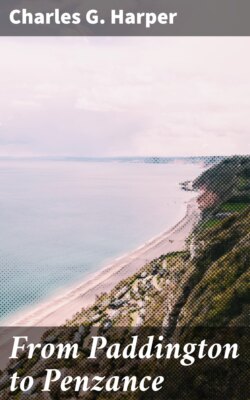Читать книгу From Paddington to Penzance - Charles G. Harper - Страница 14
На сайте Литреса книга снята с продажи.
XII.
ОглавлениеTable of Contents
We left Winchester regretfully one fine morning, going through West Gate and the suburb of Fulflood to the Stockbridge Road. “From the western gate aforesaid,” to quote Thomas Hardy’s conclusion to “Tess of the D’Urbervilles,” “as every Winton-cestrian knows, ascends a long and regular incline of the exact length of a measured mile, leaving the houses gradually behind. … The prospect from this summit was almost unlimited. In the valley beneath lay the city, its more prominent buildings showing as in an isometric drawing—among them the broad Cathedral tower, with its Norman windows and immense length of aisle and nave, the spires of Saint Thomas’s, the pinnacled tower of the College, and, more to the right, the tower and gables of the ancient hospice, where to this day the pilgrim may receive his dole of bread and ale. Behind the city swept the rotund upland of St. Catherine’s Hill; further off, landscape beyond landscape, till the horizon was lost in the radiance of the sun hanging above it. Against these far stretches of country rose, in front of the other city edifices, a large red brick building, with level grey roofs, and rows of short, barred windows bespeaking captivity, the whole contrasting greatly by its formalism with the quaint irregularities of the Gothic erections. … From the middle of the building an ugly flat-topped octagonal tower ascended against the east horizon, and viewed from this spot, on its shady side and against the light, it seemed the one blot on the city’s beauty.”
“AD PORTAS,” WINCHESTER COLLEGE.
From here Angel Clare and ‘Liza-Lu beheld the black flag announce to the city that justice had been done upon Tess: “The two speechless gazers bent themselves to earth, as if in prayer, and remained thus a long time, absolutely motionless: the flag continued to wave silently. As soon as they had strength they arose, joined hands again, and went on.”
And so, to my mind, the Stockbridge road shall be ever haunted with these two mourners who thus disappear into the void; and Roebuck Hill has acquired a literary interest that transfigures an eminence of no particular elevation, and of a certain air of suburban propriety, into a hill of sorrow. It commands Winchester Gaol, whose sordid dramas are, by the reading of that moving tale, touched with a saving tincture of romance.
BRASS, WEEKE.
Presently we came to the little village of Wyke, now more frequently called Weeke, a scattered collection of cottages, horse-pond, and tiny church at the foot of another gentle hill. Not a soul was there to be seen in Wyke. The churchyard gate was open, and also the door of the church, a building consisting of nave and chancel only, with shingled, extinguisher-like spirelet, and Norman south porch. But a mural brass, directly opposite the door, drew our attention. On examination it proved as interesting as that little effigy at Headbourne Worthy, although of entirely different character. It is monumental, in a sense, as its inscription commemorates a benefactor of the church and his wife, but the figure above is not, as usual, a portrait effigy, but, instead, a representation of Saint Christopher, shown in the act of carrying the infant Saviour across a river. The figure is only a few inches high, but carefully engraved, in 1498, a period shortly before the decadence of this ancient art began; it is, moreover, unique. Although the figure of Saint Christopher, that giant of the pretty mediæval legend, was generally to be found in fresco upon the walls of ancient churches, and was the subject of one of the earliest wood-blocks, no other brass than this is known where his striking figure is to be seen.
It is an open road, exposed and unshaded by trees, that leads from Wyke, up Harestock Hill, along the Stockbridge road, and the half-mile of avenue that shades the bye-road to Sparsholt was welcome indeed.
Sparsholt is a scattered village, on the road to nowhere in particular, and deep set in agricultural stodginess. It has a pleasing transitional-Norman church, with, attached to the living, the sinecure holding of Lainston, half-a-mile distant, whose church has been in ruins for generations. It was in those roofless walls that the notorious Duchess of Kingston was secretly wedded. There is nothing in the nature of a street to be found in Sparsholt village. Houses are few and far between in its winding lanes, and but two shops, the chiefest of them the post office, administer to the wants of this sleepy place. At the post office may be purchased anything from a postage-stamp to a Hampshire ham. The village water-supply is obtained from a well with a remarkable contrivance for raising the buckets. A large broad drum or wheel, some nine feet in diameter, is set above the well with the bucket-ropes wound round it. To raise the buckets, you step inside the drum and commence walking up its sides, resembling during the performance nothing so much as a caged squirrel.
INTERIOR, SPARSHOLT CHURCH.
